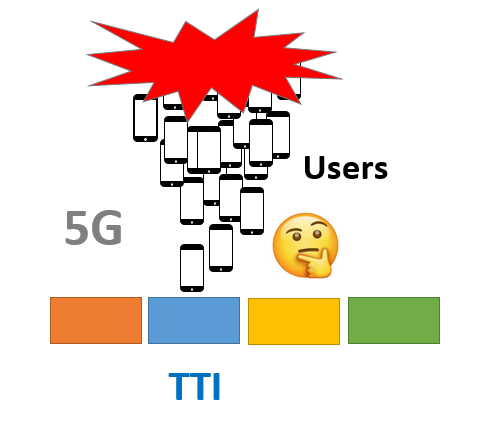Hi friends
Please help to understand how many UEs/TTI are possible in 5G?
Also kindly share 3gpp or any other references
Thanks

Hi friends
Please help to understand how many UEs/TTI are possible in 5G?
Also kindly share 3gpp or any other references
Thanks

It’s rather how many UEs gNB can schedule per slot, for 5G.
TTI scheduling is for LTE.
Certain factors are SCS used, bandwidth configured, number of PRB, hardware etc decide number of users gNB can schedule per slot.
thank you ,
is there any reference from Ieee or 3gpp?
Lets take everything to hardcore.
MU-MIMO teansmission with 8 layers DL. Minimum allocation of single RB for UE. Bandwidth of 100Mhz. Table1 max MCS. Lets say we need around 23 RB for control and rach, just because.
nUEmax = 8*(250*14)=28k
Peak Speed DL will be around
Rb = 141K bps
If you want carrierAgrigation, not remember the max number of carrier, think its 4 … then just multiply Rb or nUEmax by 4.
But you will need whole Azure and AWS dataCenteres allocated in europe to manage schedule it. Implement link adapration … hec donno how you will manage to decode RACH. Or how you optimize link and beamforming for that creature to enable UPLINK at all. Its a nightmare, but on papper possible. 
PS - however if you work SU-MIMO and leave link adapration to UE based on csiRS, it seems more possible. But we talk about 28k/8=3.5k UEs max now. (Per 100Mhz) you even may increase your rroughput by factor 4 via nLayer spatial transmission.
Its only regard to PDSCH with minimal control signals. If you intrested on how many UEs can achive control signal, need to check it. Its wheresystem eng Voodoo begins
To answer this question I will assume some bandwidth and subcarrier spacing. Answer can be scaled for different bandwidths and subcarrier spacings.
Let’s say bandwidth = 100 MHz
Subcarrier spacing = 30KHz
So number of PRBs = 273
Let’s also assume PDCCH for a given PDSCH is transmitted in the same slot.
The minimum scheduling for a UE is defined as single PRB. Since there are 273 PRBs so 273 UEs can be scheduled on a single antenna port. For MU-MIMO case for 16 layers multiplexed 273*16 = 4368 UEs can be scheduled in a TTI.
But there is a catch here. The real theoretical limit doesn’t come from PDSCH scheduling, it comes from PDCCH, number of DCIs accommodated per TTI.
Let’s say we allocate 3 OFDM symbols and 273 PRBs to PDCCH coreset. All the DCIs are being transmitted with aggregation level 1. Total 45 PRGs (= 45 DCIs with Agg. level 1) can be accommodated in a single OFDM symbol with 273 PRBs, therefore in 3 OFDM symbols we can accommodate 45*3 = 135 DCIs.
So irrespective of PDSCH resources we can’t accommodate more than 135 UEs in a single TTI.
I do not think there is a need to schedule 135 users per TTI in 5G.
Scheduler works with lower numbers and polling users periodically.
So users are served in bursts of data.
There is also the mu-MIMO option for scheduler with 16 PDSCH layers and 4 PDCCH layers.
(Values above are for Huawei).